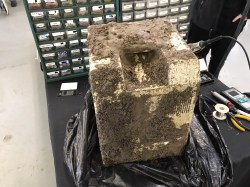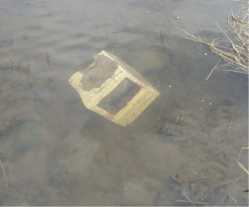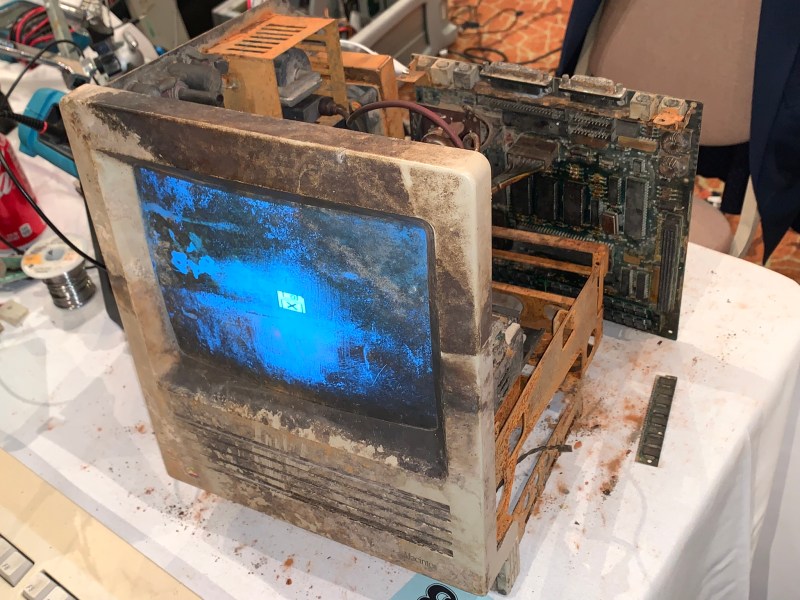Retrocomputing often involves careful restorations, rare components, and white gloves. This story involves none of those. This is the story of two people who sought to answer one of the greatest questions in the universe: What does it take to kill a Mac SE?

The star of the show here is Crusty, a Mac SE that was found on the loading dock of a scrap company. It sat out in the weather for at least 6 months, complete with the original leaking lithium battery.
Enter [RadRacer203], who is friends with the owner of this particular scrap company. [RadRacer203] and picked up Crusty, along with a few other classic Macs. He brought these machines to VCF East 2021, where our other hero comes in. [CJ] is something of a magician with CRTs and analog electronics. Trained under [Sark] himself, [CJ] has mastered the 5-finger exploding capacitor technique.
The battery had eaten through the mainboard and even into the chassis. But after a thorough cleaning, the damn thing booted up. Crusty was born.
This Mac was a survivor. Much like Top Gear and their plucky Toyota Hilux, [RadRacer203] and [CJ] devised a plan to put Crusty to the test.
Click through the break for more!
Test 1: Bury it for 6 months.
 [RadRacer203] lives on a large computer ranch. He took Crusty out to the back 40 and buried him. [CJ] is quick to mention they did remove the IWM chip before burial, as he and [RadRacer203] aren’t monsters. After 6 months underground, Crusty was dug up just in time to attend VCF East, still wearing his muddy attire. [CJ] immediately went to work. While the burial had rusted a few parts, it only took a bit of cleaning to get Crusty up and running again. The machine would not die. Obviously, this required drastic measures.
[RadRacer203] lives on a large computer ranch. He took Crusty out to the back 40 and buried him. [CJ] is quick to mention they did remove the IWM chip before burial, as he and [RadRacer203] aren’t monsters. After 6 months underground, Crusty was dug up just in time to attend VCF East, still wearing his muddy attire. [CJ] immediately went to work. While the burial had rusted a few parts, it only took a bit of cleaning to get Crusty up and running again. The machine would not die. Obviously, this required drastic measures.
Test 2: Submerge it in a creek for 8 months.

Did we mention [RadRacer203] lives on a large computer farm? This includes a creek. He chucked Crusty in and walked away. Crusty was only retrieved 8 months later when the danger of a hard freeze put the CRT itself at risk. Rather than winter in the water, Crusty became a Halloween decoration and spent some time as the head of a rather dapper looking snowman.
At this point, Crusty was a bit of a celebrity, and his next appearance at VCF East 2023 included meeting and getting signatures from several notable YouTubers. Unfortunately [CJ] wasn’t quite able to get him working this time. The 1/8-watt power supply feedback resistors rusted right off the PCB.
[CJ] was undaunted. Fast forward to VCF Midwest 2023, and he was going to give Crusty the best possible chance of running again. [CJ] had everything he needed. Except cleaning supplies. Not a problem, as there was plenty of Old Bay vodka available. This was perfect for cleaning up the boards and made everyone around hungry looking for crabcakes.
Did Crusty live? We’ll let [CJ] tell the rest of the story on his page. We’ll just say we’re in awe of his skills in bringing old decrepit hardware back to life.















so its the ak-47 of computers.
i have fond memories of the se, you could say its the machine that got me into computers. though to be fair having high scores in crystal raiders is not exactly hackery.
Finally electronic devices reached the level of barn finds, they are oficially oldtimers.
Macintosh had no NiCd, nor any rechargeable PRAM (CMOS) battery until far later machines, they first had alkaline cells untill the SE where they moved to lithium cells
Thank you, Erik. Good catch – I’ve updated the article. NiCad will mess up a board, but I’ve seen some shocking damage from lithium cells
What I find weird is that outside of Macintosh computers, I have never encountered non-rechargeable lithium cell leakage.
You have? It still says “complete with the original leaking NiCad battery” on my screen.
Interesting but probably not true story about Apple’s naming scheme. Macintosh II, when upgraded with ‘030 processor it became IIx. Macintosh IIcx was the first compact desktop model with ‘030 and IIci was the improved version. Macintosh SE would have been SEx if it wasn’t for the funny name, Apple choose to ditch the x and named the upgraded SE as SE/30
Wow,
So 2 computer collectors find a junk system with almost no value ans have lots of fun with it after removing the only useful parts. And on hackaday we have so may snowflake comments about this.
I have only one thing to say to those unapproving of this is
—— LIGHTEN UP FRANCIS ——
Nothing of value was damaged. I’m sorry but Mac SE’s have almost no collector value in the US. This computer was damaged beyond reasonable repair. I know some people repair them but that’s for their own reasons and YouTube channel.
— Not everything is worth fixing —
This was a fun experiment with a worthless system. Enjoy it in the fun spirit it was done in.
What is the “IWM chip” and why did it need to be removed?
IIRC that stands for Integrated Woz Machine and should be the floppy controller. Since I didn’t watch the video (yet), I can’t answer why, but my guess is “cos it’s broke”.
nevermind, it’s in the expanded article, not in the video.
So the answer to why they removed the IWM is because they’re fragile and are getting somewhat rare. If I had to do the same experiment on a Commodore 64, I’d remove the SID chip for the same reason. And on US machines, the VIC-II chip as well (in 20 machines I only came across one bad VIC-II here in Germany)
I’m from Germany, too and agree with you about the SID being the most precious part. The 6810 and 7805 would be worth saving, too, I think.
That being said, any Macintosh is more worth than any C64 in my opinion. The Motorola 68000 alone is. Macs were usable as tools, the programmer’s equivalent to a venerable Bosch drilling machine. Such “experiments” break my heart.
I generally never understood why those Americans love destroying things so much. Still don’t to be honest. Even our radio amateur friends who I thought were being civilized seem to have destroyed things for fun on ham fairs in the past (such as tube radios when solid-state was new).. That’s what I read years ago, at least. I hope it’s just a rumor.
Sorry about that remark, but the article w/ the pictures was somewhat offensive to me that I felt triggered. Never mind and thanks everyone for your understanding.
The IWM chip and roms are different between the normal SE and the Superdrive because the Superdrive had an HD floppy in it, so this being a Superdrive, I took the roms and IWM out to upgrade my normal SE to HD floppy and this got the normal roms
Having seen the repair work for myself, it’s highly impressive that a machine so badly damaged upon acquisition could be coaxed back to life.
Crusty is love, Crusty is life.
Hm. Some people set things on fire, blow it up, put it in a microwave, smash it or shoot at it. This one was just left to die. Impressive, I suppose.
What exactly is the 5-finger exploding capacitor technique?
I could tell you, but unfortunately you need a government-issued License to Kill in order to possess such information legally
Legend says that only those who are truly trusted by the electrician masters are taught the secret of the incredible 5-finger exploding capacitor technique.
There are now only 3 people alive who know the incredible 5-finger exploding capacitor technique. Each one ascended the Jacob’s ladder to the heights of mount Voltage and entreated the master to become an apprentice. Each one scorched their hands on a soldering iron day in, day out for years, while learning the hidden nuances of Ohm’s law. At the culmination of their apprenticeship and after their years of loyal service the master taught them each the incredible 5-finger exploding capacitor technique. One of them has never used it. One of them used it once to betray the master. One of them has vowed to use it once more, to get their revenge.
You, I like your style
So you find an old computer that is still working and you wonder, how can this be destroyed? I mean it was never in good condition to begin with, but man.
It’s impressive how the point of this goes so far over people’s heads.
The point was to show how repairable these things are and how “too far gone” is in the eye of the beholder. Not in any one description or condition.
Another fantastic point to this story is that [CJ] did not necessarily possess all the skills to do every repair he did before getting and working on this machine. BUT he did learn a LOT while working on it. A lot of people will get machines, call it too far gone, then just throw it away instead of ATTEMPTING to repair it! And that is much more of a waste than taking a fairly trashed machine already and making it worse to teach a lesson and to learn a LOT of troubleshooting skills.
Yay, heavy metals in a creek. Awesome!
> Yay, heavy metals in a creek. Awesome!
+1
Kai Robinson did a fantastic job recreating the pcb